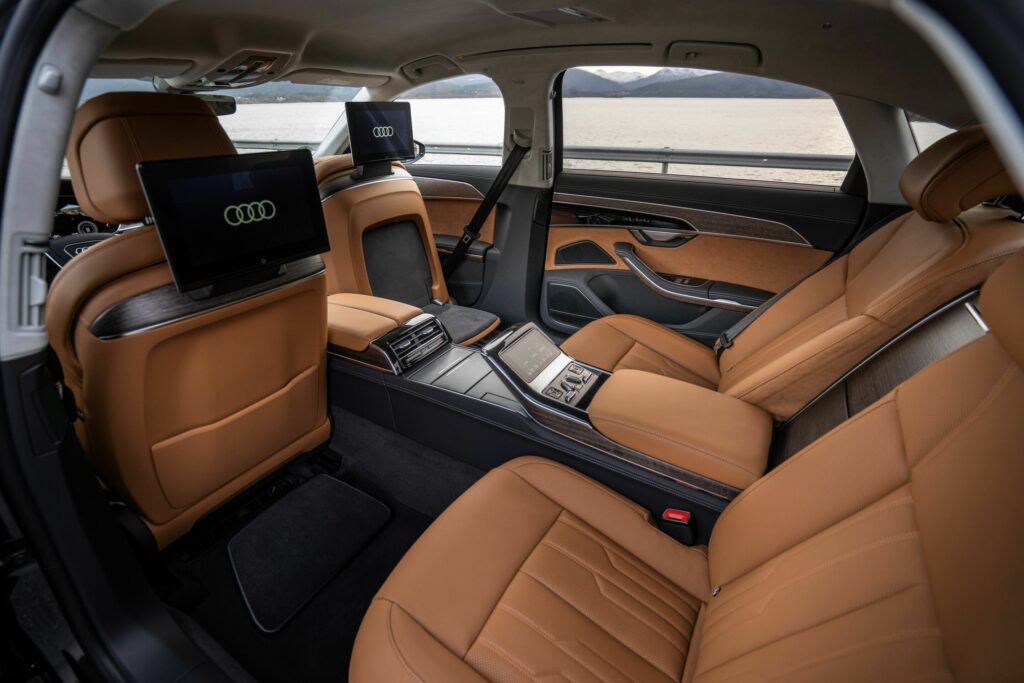The advent of self-driving cars is no longer a distant dream but a tangible reality reshaping the future of transportation. Autonomous vehicles (AVs) promise enhanced safety, efficiency, and convenience, revolutionizing how we commute. Here, we explore seven self-driving cars currently on the market, highlighting their features, capabilities, and the technology driving this groundbreaking innovation.

1. Tesla Model S

Overview:
Tesla has been at the forefront of autonomous driving technology, and the Model S is a prime example of their innovation. Equipped with Tesla’s Full Self-Driving (FSD) suite, the Model S can navigate complex driving scenarios with minimal human intervention.
Price Range: Rs. 70.00 Lakh
Key Features:
- Autopilot and FSD: Navigate on Autopilot, auto lane change, and auto park.
- Hardware: Eight surround cameras, twelve ultrasonic sensors, and a forward-facing radar.
- Updates: Over-the-air software updates for continuous improvement.


Performance:
The Model S is known for its impressive acceleration and long-range capabilities, making it a top choice for those seeking luxury and cutting-edge technology.
2. Waymo One

Overview:
Waymo, a subsidiary of Alphabet Inc., has developed a fully autonomous ride-hailing service known as Waymo One. Operating primarily in Phoenix, Arizona, Waymo’s fleet of self-driving Chrysler Pacifica minivans offers a glimpse into the future of public transportation.
Price Range: A five-mile, 20-minute Waymo ride cost $11
Key Features:
– LiDAR and Radar: Advanced sensor fusion for 360-degree vision and real-time data processing.
– Safety: Redundant systems to ensure safety and reliability.
– User Experience: App-based service with real-time ride tracking.


Performance:
Waymo One provides a smooth and safe ride, demonstrating the potential for AVs in ride-sharing and public transport sectors.
3. Audi A8

Overview:
The Audi A8 is one of the first production cars to offer Level 3 autonomous driving capabilities. Audi’s Traffic Jam Pilot allows the A8 to handle certain driving tasks autonomously under specific conditions.
Price Range: Rs.1.34 crore to Rs 1.62 crore
Key Features:
– Traffic Jam Pilot: Handles driving at speeds up to 60 km/h on highways.
– AI and Sensors: Uses a combination of LiDAR, radar, cameras, and ultrasonic sensors.
– Luxury: Premium interiors with advanced infotainment and comfort features.


Performance:
The Audi A8 blends luxury with advanced technology, providing a semi-autonomous driving experience that enhances comfort and convenience.
4. Nissan Leaf

Overview:
The Nissan Leaf, a popular electric vehicle, incorporates Nissan’s Pro PILOT Assist technology, offering a suite of driver-assist features that bring it closer to autonomous driving.
Price Range: estimated price of ₹ 30 Lakh.
Key Features:
– Pro PILOT Assist: Adaptive cruise control, lane-keeping assist, and traffic jam assist.
– E-Pedal: Allows for one-pedal driving, enhancing control and efficiency.
– Safety: Equipped with Nissan Safety Shield 360, including automatic emergency braking and blind-spot monitoring.


Performance:
The Leaf’s combination of electric efficiency and advanced driver-assist features makes it a compelling option for eco-conscious drivers looking for a taste of autonomous technology.
5. Mercedes-Benz S-Class

Overview:
The Mercedes-Benz S-Class has long been a benchmark for automotive luxury and innovation. The latest model includes the Drive Pilot system, offering Level 3 autonomous capabilities under certain conditions.
Price Range: S-Class Diesel price in India is ₹ 1.77 Crore
Key Features:
– Drive Pilot: Handles driving at speeds up to 60 km/h on suitable highways.
– MBUX System: Advanced infotainment with AI-driven user interface.
– Safety: Comprehensive suite of driver-assist features and safety systems.


Performance:
The S-Class delivers a luxurious driving experience with cutting-edge technology, making it a top choice for those seeking both comfort and automation.
6. BMW iX

The BMW iX is a groundbreaking electric SUV that showcases BMW’s latest advancements in autonomous driving and connectivity. With the Driving Assistant Professional package, the iX offers a range of semi-autonomous features.
Price Range: BMW iX price for the base model starts at Rs. 1.21 Crore
Key Features:
– Driving Assistant Professional: Includes adaptive cruise control, lane-keeping assist, and traffic jam assist.
– Interior: Luxurious and tech-forward cabin with a large curved display.
– Electric Range: Impressive range and fast-charging capabilities.


Performance:
The iX combines BMW’s signature driving dynamics with innovative autonomous features, providing a futuristic driving experience in an electric package.
7. Volvo XC90

Overview:
Volvo is known for its commitment to safety, and the XC90 reflects this ethos with its advanced driver-assist technologies. The Pilot Assist system provides a semi-autonomous driving experience on highways.
Price Range: Volvo XC90 Ex-Showroom price starts at Rs 96.50 Lakh.
Key Features:
– Pilot Assist: Adaptive cruise control with lane-keeping assist and traffic jam assist.
– Safety Features: Includes City Safety with pedestrian, cyclist, and large animal detection.
– Interior: Scandinavian design with premium materials and advanced infotainment.


Performance:
The XC90 offers a balance of safety, luxury, and semi-autonomous driving capabilities, making it a family-friendly option for those interested in cutting-edge technology.
The rise of self-driving cars marks a significant milestone in the evolution of the automotive industry. Each of these seven vehicles—Tesla Model S, Waymo One, Audi A8, Nissan Leaf, Mercedes-Benz S-Class, BMW iX, and Volvo XC90—showcases unique features and advancements in autonomous driving technology. While fully autonomous cars are still on the horizon, these models offer a glimpse into the future, demonstrating how AVs can enhance safety, convenience, and overall driving experience.
Tips for Potential Buyers:
1. Research: Understand the level of autonomy each vehicle offers and the specific features included.
2. Test Drive: Experience the autonomous features firsthand to see how they handle real-world scenarios.
3. Safety: Consider the vehicle’s safety ratings and the reliability of its autonomous systems.
4. Updates: Ensure the vehicle can receive over-the-air updates to stay current with the latest advancements.
As we move towards a more autonomous future, these cars represent the cutting edge of automotive technology, paving the way for safer, smarter, and more efficient transportation.
For more such blogs click here.
